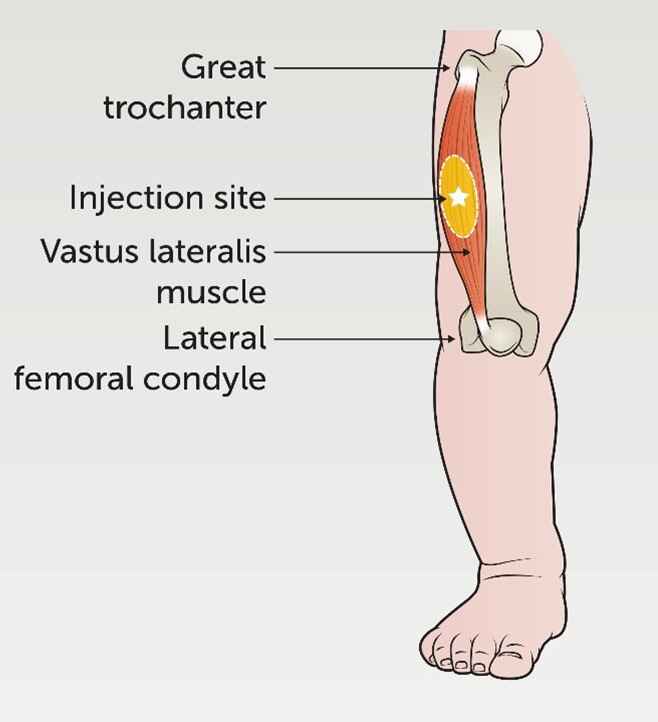Immediate Newborn Care > Maternal & Newborn
Exam Review
Vitamin K Injection
Total Questions : 4
Showing 4 questions, Sign in for moreA nurse is preparing to administer vitamin K injection to a newborn.
Which of the following actions should the nurse take before drawing up the medication?
Explanation
The correct answer is choice C. Check the medication label for the name, dose, expiry date and route of administration.
This is a standard precaution that should be taken before administering any medication to ensure patient safety and avoid medication errors.
Choice A is wrong because checking the newborn’s blood type and Rh factor is not necessary before giving vitamin K injection.
Vitamin K is not a blood product and does not depend on blood compatibility.
Choice B is wrong because checking the newborn’s bilirubin level and jaundice score is not relevant to vitamin K injection.Vitamin K is given to prevent vitamin K deficiency bleeding (VKDB), which is a serious condition that can cause bleeding in the brain or other organs.
Bilirubin level and jaundice score are indicators of neonatal jaundice, which is a common condition that causes yellowing of the skin and eyes due to excess bilirubin in the blood.
Choice D is wrong because checking the newborn’s weight and length measurements is not required before giving vitamin K injection.The recommended dose of vitamin K for newborns weighing more than 1500 g is 1 mg as a single intramuscular injection within 6 hours of birth.For preterm infants weighing less than 1500 g, the dose is 0.3 mg/kg to 0.5 mg/kg.
The dose does not depend on the exact weight or length of the newborn.
A nurse is administering vitamin K injection to a newborn using the vastus lateralis muscle as the injection site.
Which of the following techniques should the nurse use to ensure proper needle placement?
Explanation
The correct answer is choice B. Locate the greater trochanter and the lateral femoral condyle and use the middle third of this line.This technique ensures proper needle placement in the vastus lateralis muscle, which is the preferred site for vitamin K injection in newborns.Vitamin K is given to prevent vitamin K deficiency bleeding (VKDB), which can cause serious bleeding problems in newborns.
Choice A is wrong because dividing the thigh into thirds horizontally and vertically and using the outer middle third of the thigh is a technique for locating the dorsogluteal site, which is not recommended for newborns.
Choice C is wrong because palpating the anterior iliac spine and the mid-patella and using the lateral aspect of this line is a technique for locating the rectus femoris site, which is an alternative site for vitamin K injection in newborns but not as preferred as the vastus lateralis site.
Choice D is wrong because identifying the midpoint of a line drawn from the anterior superior iliac spine to the pubic tubercle and using this point is a technique for locating the ventrogluteal site, which is not recommended for newborns.

A nurse has administered vitamin K injection to a newborn.
Which of the following statements by the nurse indicates an understanding of the rationale for this intervention?
Explanation
The correct answer is choice A. This injection will help prevent your baby from developing a bleeding disorder caused by low vitamin K levels.
Vitamin K is essential for the synthesis of clotting factors in the liver.
Newborns have low levels of vitamin K because it does not cross the placenta well and they have limited gut flora to produce it.
Therefore, they are at risk of vitamin K deficiency bleeding (VKDB), which can cause serious and potentially fatal hemorrhages.To prevent VKDB, the American Academy of Pediatrics recommends a single intramuscular dose of 1 mg of vitamin K to all newborn infants within 6 hours of birth.
Choice B is wrong because vitamin K does not boost the immune system or protect from infections.
Choice C is wrong because vitamin K does not stimulate liver function or metabolism.
Choice D is wrong because vitamin K does not increase appetite or growth.
A nurse is caring for a newborn who did not receive vitamin K injection at birth due to parental refusal.
Which of the following signs and symptoms should alert the nurse to a possible vitamin K deficiency bleeding (VKDB)?
Explanation
The correct answer is choice A.Petechiae, ecchymosis, or oozing from puncture sites are signs and symptoms of vitamin K deficiency bleeding (VKDB) in newborns.VKDB is a rare form of bleeding disorder that affects newborns and young infants due to low stores of vitamin K at birth.Vitamin K is a substance that our body needs to form clots and to stop bleeding.
Choice B is wrong because pallor, tachycardia, or poor perfusion are signs of anemia or shock, which can have many causes other than VKDB.
Choice C is wrong because jaundice, dark urine, or clay-colored stools are signs of liver disease or biliary obstruction, which can affect vitamin K absorption but are not specific for VKDB.
Choice D is wrong because hypoglycemia, lethargy, or jitteriness are signs of low blood sugar or neonatal abstinence syndrome, which are not related to VKDB.
Sign Up or Login to view all the 4 Questions on this Exam
Join over 100,000+ nursing students using Nursingprepexams’s science-backend flashcards, practice tests and expert solutions to improve their grades and reach their goals.
Sign Up Now

